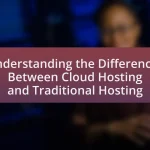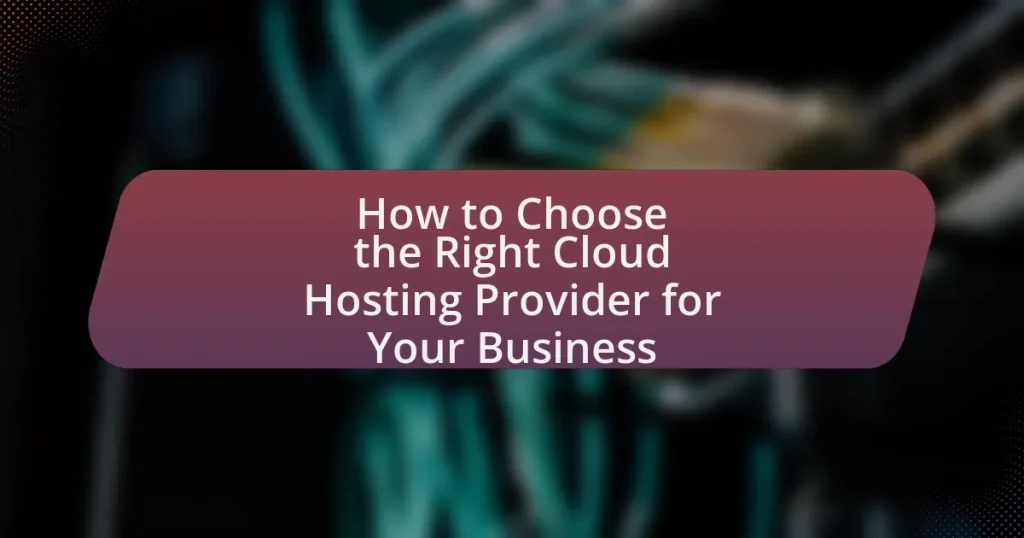The article focuses on how to choose the right cloud hosting provider for businesses, emphasizing critical factors such as reliability, scalability, security, and customer support. It outlines the influence of specific business needs on provider selection, detailing the importance of identifying operational requirements, compliance obligations, and budget constraints. The article also compares different types of cloud hosting services, including public, private, and hybrid options, and discusses the significance of security features and compliance with regulations. Additionally, it provides guidance on evaluating potential providers, assessing pricing models, and implementing effective management practices post-migration to optimize cloud hosting experiences.
What Should You Consider When Choosing a Cloud Hosting Provider?
When choosing a cloud hosting provider, consider factors such as reliability, scalability, security, and customer support. Reliability is crucial, as it ensures minimal downtime; for instance, providers like Amazon Web Services and Microsoft Azure boast uptime guarantees of 99.99%. Scalability allows your resources to grow with your business needs, which is essential for adapting to changing demands. Security features, including data encryption and compliance with regulations like GDPR, protect sensitive information. Lastly, robust customer support, available 24/7, is vital for resolving issues promptly, as evidenced by providers that offer multiple support channels, including live chat and phone support.
How do your business needs influence your choice of a cloud hosting provider?
Business needs significantly influence the choice of a cloud hosting provider by dictating requirements such as scalability, security, and compliance. For instance, a rapidly growing business may prioritize a provider that offers flexible scaling options to accommodate increasing workloads, while a company in a regulated industry might require a provider with robust security measures and compliance certifications, such as ISO 27001 or HIPAA. Additionally, specific applications or workloads may necessitate particular performance metrics, such as low latency or high availability, which can further narrow down the selection of suitable providers.
What specific requirements should you identify for your business?
To identify specific requirements for your business when choosing a cloud hosting provider, you should assess your operational needs, budget constraints, and compliance obligations. Operational needs include evaluating the necessary storage capacity, bandwidth, and scalability to accommodate growth. Budget constraints involve determining the total cost of ownership, including subscription fees and potential hidden costs. Compliance obligations require understanding industry regulations and data protection laws relevant to your business, such as GDPR or HIPAA. These factors collectively ensure that the selected cloud hosting solution aligns with your business objectives and operational framework.
How do scalability and flexibility play a role in your decision?
Scalability and flexibility are critical factors in choosing a cloud hosting provider because they ensure that the infrastructure can grow and adapt to changing business needs. Scalability allows businesses to increase or decrease resources based on demand, which is essential for managing costs and performance effectively. For instance, a study by Gartner indicates that organizations that leverage scalable cloud solutions can reduce IT costs by up to 30% while improving service delivery. Flexibility complements scalability by enabling businesses to customize their hosting solutions, integrating various services and applications as needed. This adaptability is vital for businesses facing fluctuating workloads or rapid growth, as it allows them to respond quickly to market changes without significant downtime or investment in new infrastructure.
What types of cloud hosting services are available?
There are several types of cloud hosting services available, including Infrastructure as a Service (IaaS), Platform as a Service (PaaS), Software as a Service (SaaS), and Function as a Service (FaaS). IaaS provides virtualized computing resources over the internet, allowing businesses to rent servers and storage. PaaS offers a platform allowing developers to build, deploy, and manage applications without dealing with the underlying infrastructure. SaaS delivers software applications over the internet on a subscription basis, eliminating the need for installation and maintenance. FaaS enables developers to execute code in response to events without managing servers, promoting a serverless architecture. Each type serves different business needs and operational models, making it essential for companies to choose the right service based on their specific requirements.
What are the differences between public, private, and hybrid cloud hosting?
Public cloud hosting is a service where resources are shared over the internet and managed by third-party providers, making it cost-effective and scalable. Private cloud hosting, in contrast, offers dedicated resources for a single organization, providing enhanced security and control, often hosted on-premises or through a private data center. Hybrid cloud hosting combines elements of both public and private clouds, allowing data and applications to be shared between them, which offers flexibility and optimized resource use. These distinctions are crucial for businesses to consider when selecting a cloud hosting solution that aligns with their specific needs for security, scalability, and cost.
How do managed and unmanaged cloud hosting options compare?
Managed cloud hosting provides a comprehensive service where the provider handles server management, maintenance, and support, while unmanaged cloud hosting requires users to manage their own servers, including setup, maintenance, and troubleshooting. This distinction means that managed options are typically more user-friendly and suitable for businesses lacking technical expertise, as they offer 24/7 support and automatic updates. In contrast, unmanaged options offer greater control and flexibility, appealing to technically skilled users who prefer to customize their environments and potentially reduce costs. According to a report by Gartner, businesses that opt for managed services can reduce operational costs by up to 30% due to decreased downtime and improved efficiency.
Why is security a critical factor in selecting a cloud hosting provider?
Security is a critical factor in selecting a cloud hosting provider because it directly impacts the protection of sensitive data and compliance with regulations. Cloud providers face constant threats from cyberattacks, and a breach can lead to significant financial losses, reputational damage, and legal consequences. For instance, according to a report by IBM, the average cost of a data breach in 2021 was $4.24 million, highlighting the financial risks associated with inadequate security measures. Therefore, evaluating a provider’s security protocols, such as encryption, access controls, and incident response plans, is essential to ensure that data remains secure and compliant with industry standards.
What security features should you look for in a cloud hosting provider?
When selecting a cloud hosting provider, you should look for robust security features such as data encryption, multi-factor authentication, and regular security audits. Data encryption ensures that sensitive information is protected both in transit and at rest, making it inaccessible to unauthorized users. Multi-factor authentication adds an additional layer of security by requiring users to provide two or more verification factors to gain access, significantly reducing the risk of unauthorized access. Regular security audits help identify vulnerabilities and ensure compliance with industry standards, thereby enhancing the overall security posture of the cloud environment. These features collectively contribute to a secure cloud hosting experience, safeguarding your business data against potential threats.
How can compliance with regulations impact your choice?
Compliance with regulations significantly impacts the choice of a cloud hosting provider by ensuring that the selected provider adheres to legal and industry standards. For instance, businesses in sectors like healthcare or finance must comply with regulations such as HIPAA or PCI-DSS, which dictate stringent data protection and privacy measures. Choosing a provider that meets these compliance requirements not only mitigates legal risks but also enhances customer trust and security. According to a report by Gartner, 70% of organizations cite compliance as a critical factor in their cloud service selection process, highlighting its importance in decision-making.
How Can You Evaluate Potential Cloud Hosting Providers?
To evaluate potential cloud hosting providers, assess their performance, security, scalability, and support services. Performance can be measured through uptime guarantees, typically around 99.9%, and speed benchmarks provided by independent testing. Security should include data encryption, compliance with standards like GDPR or HIPAA, and regular security audits. Scalability is crucial; providers should offer flexible plans that can grow with your business needs, often demonstrated through customer case studies. Lastly, evaluate support services by checking availability of 24/7 customer support, response times, and user reviews on platforms like G2 or Trustpilot.
What criteria should you use to assess cloud hosting providers?
To assess cloud hosting providers, evaluate criteria such as reliability, performance, security, scalability, and customer support. Reliability is crucial; look for providers with a proven uptime record, ideally above 99.9%. Performance can be gauged through speed and latency metrics, which impact user experience. Security measures should include data encryption, compliance with standards like GDPR, and regular security audits. Scalability allows businesses to adjust resources based on demand, ensuring cost-effectiveness. Lastly, customer support should be accessible and responsive, with multiple channels for assistance. These criteria collectively ensure that the chosen provider meets business needs effectively.
How important is uptime and reliability in your evaluation?
Uptime and reliability are critically important in the evaluation of a cloud hosting provider. High uptime percentages, typically above 99.9%, ensure that services remain accessible to users, which directly impacts business operations and customer satisfaction. For instance, a study by Gartner indicates that downtime can cost businesses an average of $5,600 per minute, highlighting the financial implications of unreliable services. Therefore, prioritizing uptime and reliability is essential for maintaining operational efficiency and trust with customers.
What role do customer support and service level agreements (SLAs) play?
Customer support and service level agreements (SLAs) are critical in ensuring reliable service and customer satisfaction in cloud hosting. Customer support provides assistance and resolves issues, while SLAs define the expected level of service, including uptime guarantees and response times. For instance, a typical SLA may guarantee 99.9% uptime, which assures businesses that their services will be available most of the time, thereby minimizing potential revenue loss. Effective customer support, backed by clear SLAs, enhances trust and helps businesses make informed decisions when selecting a cloud hosting provider.
How can you compare pricing models among different providers?
To compare pricing models among different providers, analyze the structure of each provider’s pricing, including base costs, additional fees, and usage-based charges. Start by gathering detailed pricing information from each provider’s website or sales documentation, focusing on key elements such as monthly fees, per-user costs, and any tiered pricing options. Additionally, consider the services included in each pricing model, such as storage limits, bandwidth, and support levels.
For instance, a study by Gartner in 2022 highlighted that cloud providers often have varying pricing strategies, with some offering flat-rate pricing while others utilize pay-as-you-go models. This variance can significantly impact total costs based on usage patterns. By creating a comparison chart that outlines these factors, businesses can make informed decisions based on their specific needs and budget constraints.
What are the common pricing structures for cloud hosting services?
Common pricing structures for cloud hosting services include pay-as-you-go, subscription-based, and tiered pricing models. Pay-as-you-go allows users to pay only for the resources they consume, making it flexible and cost-effective for varying workloads. Subscription-based pricing involves a fixed monthly or annual fee for a set amount of resources, providing predictability in budgeting. Tiered pricing offers different levels of service at varying price points, allowing businesses to choose a plan that fits their needs and scale as necessary. These structures are widely adopted by major providers like Amazon Web Services, Microsoft Azure, and Google Cloud Platform, reflecting industry standards for cost management and resource allocation.
How can you estimate total costs based on your usage patterns?
To estimate total costs based on your usage patterns, analyze your historical usage data to identify trends in resource consumption. By reviewing metrics such as CPU usage, storage needs, and bandwidth consumption over a defined period, you can project future costs based on your cloud provider’s pricing model. For instance, if your data shows a consistent increase in storage needs of 10% per month, you can calculate the expected storage costs by applying this growth rate to your current expenses. Additionally, many cloud providers offer cost calculators that allow you to input your usage patterns to generate an estimated monthly cost, providing a more tailored financial forecast.
What reviews and testimonials should you consider?
Consider reviews and testimonials that provide detailed insights into the performance, reliability, and customer support of cloud hosting providers. Reviews from reputable tech websites, such as TechRadar or PCMag, often include expert evaluations and user feedback, which can highlight strengths and weaknesses. Additionally, testimonials from verified users on platforms like G2 or Trustpilot can offer real-world experiences regarding uptime, speed, and service responsiveness. These sources are valuable as they aggregate diverse opinions and experiences, helping potential customers make informed decisions based on factual data and user satisfaction ratings.
How can you find credible reviews of cloud hosting providers?
To find credible reviews of cloud hosting providers, utilize reputable technology review websites and forums that specialize in cloud services. Websites like G2, Trustpilot, and Capterra aggregate user reviews and ratings, providing insights into the performance and reliability of various providers. Additionally, industry-specific forums and communities, such as Reddit or Stack Overflow, often contain discussions and personal experiences shared by users, which can further validate the credibility of the reviews.
What red flags should you watch for in customer feedback?
Red flags to watch for in customer feedback include consistent complaints about service reliability, poor customer support responses, and unclear pricing structures. These issues indicate potential problems with the cloud hosting provider’s performance and transparency. For instance, if multiple customers report frequent downtime, it suggests that the provider may not have adequate infrastructure or support systems in place. Similarly, negative feedback regarding customer service can highlight a lack of responsiveness, which is critical for resolving issues promptly. Lastly, ambiguous pricing can lead to unexpected costs, signaling that the provider may not be trustworthy.
What Are the Next Steps After Choosing a Cloud Hosting Provider?
After choosing a cloud hosting provider, the next steps include setting up your account, configuring your cloud environment, and migrating your data. Setting up your account involves creating user credentials and selecting your service plan. Configuring your cloud environment requires defining your architecture, including virtual machines, storage options, and network settings. Migrating your data entails transferring existing applications and files to the new cloud infrastructure, which may involve using migration tools or services provided by the hosting provider. These steps are essential to ensure a smooth transition and optimal performance in the cloud environment.
How do you migrate your existing data to the new cloud hosting provider?
To migrate your existing data to a new cloud hosting provider, first, assess the data to determine its size, type, and sensitivity. Next, choose a migration method, such as direct transfer, backup and restore, or using a migration tool provided by the new provider. After selecting the method, ensure that you have a reliable backup of your data to prevent loss during the migration process. Finally, execute the migration, monitor the transfer for any issues, and verify the integrity of the data once the migration is complete. This approach is validated by industry best practices, which emphasize the importance of planning and data verification in successful cloud migrations.
What best practices should you follow during the migration process?
During the migration process, it is essential to follow best practices such as thorough planning, data backup, and testing. Thorough planning involves assessing current infrastructure and defining clear objectives for the migration, which helps in minimizing disruptions. Data backup is crucial to prevent loss during the transition; organizations should ensure that all critical data is securely backed up before starting the migration. Testing the migration in a controlled environment allows for identifying potential issues and ensuring that applications function correctly post-migration. These practices are supported by industry standards, which emphasize the importance of a structured approach to minimize risks and ensure a successful migration.
How can you ensure minimal downtime during migration?
To ensure minimal downtime during migration, implement a phased migration strategy. This approach allows for transferring data and applications in stages, reducing the risk of complete service interruption. Additionally, utilizing load balancing can distribute traffic between the old and new systems, ensuring users experience continuous access. According to a study by the International Journal of Cloud Computing and Services Science, phased migrations can reduce downtime by up to 70% compared to traditional methods.
What ongoing management practices should you implement?
To ensure effective cloud hosting management, implement regular performance monitoring, security audits, and cost optimization practices. Performance monitoring involves tracking uptime, response times, and resource usage to maintain service quality. Security audits should be conducted periodically to identify vulnerabilities and ensure compliance with industry standards, such as ISO 27001. Cost optimization practices include analyzing usage patterns and adjusting resources accordingly to avoid unnecessary expenses, which can lead to savings of up to 30% according to a study by Gartner.
How can you monitor performance and security post-migration?
To monitor performance and security post-migration, implement a combination of monitoring tools and security protocols. Utilizing application performance monitoring (APM) tools, such as New Relic or Datadog, allows for real-time tracking of application performance metrics, including response times and error rates. Additionally, employing security information and event management (SIEM) systems, like Splunk or LogRhythm, enables the detection of security incidents by analyzing logs and alerts from various sources. Regularly reviewing these metrics and alerts ensures that any performance degradation or security threats are promptly identified and addressed, thereby maintaining optimal operational integrity in the cloud environment.
What strategies can you use for regular backups and updates?
To ensure regular backups and updates, implement automated backup solutions and schedule regular update intervals. Automated backup solutions, such as cloud-based services, can perform backups without manual intervention, reducing the risk of human error. Scheduling updates at consistent intervals, such as weekly or monthly, ensures that software remains current and secure. According to a 2021 study by the Cybersecurity & Infrastructure Security Agency, organizations that regularly update their systems reduce vulnerabilities by up to 80%.
What tips can help you maximize your cloud hosting experience?
To maximize your cloud hosting experience, prioritize selecting a provider that offers scalability, reliability, and robust security features. Scalability ensures that your resources can grow with your business needs, allowing for seamless upgrades without downtime. Reliability is crucial; choose a provider with a strong uptime guarantee, ideally 99.9% or higher, to ensure your services remain accessible. Additionally, robust security features, such as data encryption and regular backups, protect your sensitive information from breaches. According to a report by Gartner, organizations that prioritize these factors experience up to 30% lower operational costs and improved performance, validating the importance of these tips in enhancing your cloud hosting experience.
How can you optimize your cloud resources for better performance?
To optimize cloud resources for better performance, implement auto-scaling to adjust resources based on demand. Auto-scaling allows systems to automatically increase or decrease resources, ensuring that applications run efficiently during peak and off-peak times. According to a study by Amazon Web Services, businesses that utilize auto-scaling can reduce costs by up to 30% while maintaining performance levels. Additionally, regularly monitoring and analyzing resource usage through cloud management tools can identify inefficiencies and help in reallocating resources effectively.
What common pitfalls should you avoid when using cloud hosting services?
When using cloud hosting services, common pitfalls to avoid include inadequate security measures, lack of scalability, and poor vendor support. Inadequate security can lead to data breaches, as a study by IBM found that the average cost of a data breach is $3.86 million. Lack of scalability can hinder business growth; according to Gartner, 70% of organizations experience challenges in scaling their cloud services. Poor vendor support can result in prolonged downtime, negatively impacting business operations, as reported by a survey from ITIC, which indicated that 98% of organizations say a single hour of downtime costs over $100,000.










